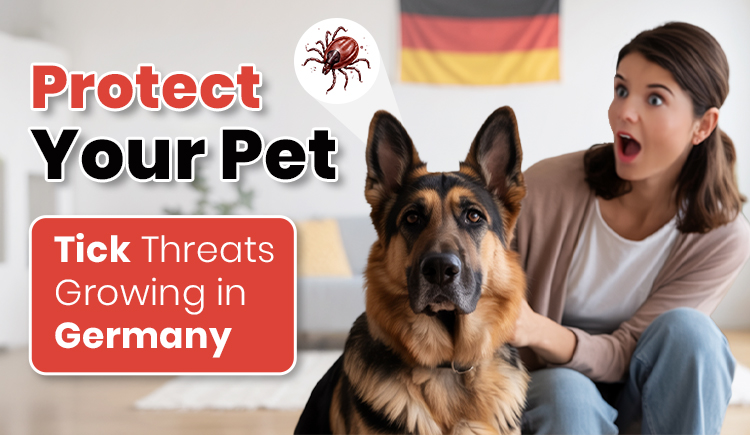Germany is home to architectural marvels, music and culture, and picturesque lush greens. However, it’s also becoming the breeding ground for a rapidly growing threat of ticks. What’s worrying is that these tiny blood-sucking parasites are no longer a seasonal concern; they are becoming a year-round issue.
In this informative blog, we’ll cover the most common tick species in Germany and explore the factors that are fueling their rise. We’ll also discuss some of the popular treatments available, along with practical prevention tips to help keep your furry companions safe. Having this knowledge will help you take timely measures and stay ahead of this growing concern and protect your pet’s health and happiness.
We’re jumping right into it!
Common Tick Species in Pets
Ticks are small blood-sucking parasites that are not just unpleasant; they pose real health risks to pets. Once attached, they can transmit a variety of pathogens, which may lead to health issues such as skin irritation, allergies, weakness, anemia, and cause severe diseases.
Some of the common tick species in Germany are wood ticks, sheep ticks or castor bean ticks, ornate dog ticks or marsh ticks, and brown dog ticks. Other species found in Germany include hedgehog ticks (Ixodes hexagonus), passerine ticks (Ixodes frontalis), pigeon ticks (Argas reflexus), etc.
Factors Highlighting the Growing Threat of Ticks in Germany
The following factors will help you put things into perspective about how ticks are becoming a growing concern for the people and pets of Germany.
Climate change
The change in the climate is among the primary reasons for the growing risk of ticks in Germany. With the rising temperature, the tick season is extending, leading to earlier reproduction and a greater risk of tick-borne diseases. Moreover, the changing precipitation patterns also provide ideal humid conditions for ticks to survive and thrive.
Wider distribution of ticks
With the rise in temperature and milder winters providing more favorable conditions, the reign of ticks is on the rise in Germany. This wider distribution of ticks is increasing the risk of tick-borne diseases for people and pets throughout the country.
New tick species
In addition to climate change, migratory birds, traveling, and freight are also contributing to the spread of both native and exotic tick species in Germany. In recent years, new tick species like the common wood ticks, alluvial forest ticks, and Hyalomma ticks have been increasingly detected.
Increased Tick-borne Encephalitis (TBE) Cases
The annual number of TBE cases is rising at an alarming rate and has nearly doubled in recent years. Moreover, there’s also the risk of Lyme disease and other diseases like anaplasmosis, tick-borne encephalitis, babesiosis, or ehrlichiosis in dogs.
Popular Treatments
To ensure comprehensive protection for your pets, you can look into these following popular treatments formulated to protect dogs against ticks.
Bravecto
Bravecto is a potent oral treatment formulated to protect dogs and puppies against a range of parasites. With fluralaner as the active ingredient, these chewables kill adult fleas and are indicated for the treatment and prevention of flea infestation.
Bravecto for dogs treats and controls a range of ticks, including black-legged ticks, American dog ticks, brown dog ticks, and Asian long-horned ticks, for 12 weeks. Plus, it treats and controls lone star ticks for 8 weeks. Suitable for dogs and puppies from 6 months of age, weighing at least 4.4 lbs., it’s also safe for breeding, pregnant, and lactating dogs.
Nexgard
Nexgard is a beef-flavored chewable treatment designed to protect dogs against a range of parasites. These chews contain Afoxolaner as the active ingredient and effectively kill adult fleas and help prevent flea infestations.
Nexgard for dogs is indicated for the treatment and control of tick infestations caused by black-legged ticks, American dog ticks, lone star ticks, brown dog ticks, and long-horned ticks. These monthly chews are recommended for dogs and puppies from 8 weeks of age and weighing at least 4 lbs. Plus, they also assist in the prevention of Lyme disease.
Simparica
Simparica is a popular oral flea and tick treatment for dogs from 6 months of age. These flavored chewable tablets contain Sarolaner as the active ingredient and effectively kill adult fleas and prevent flea infestations.
Additionally, Simparica flea and tick chews treat and control lone star ticks, Gulf Coast ticks, American dog ticks, black-legged ticks, brown dog ticks, and Asian long-horned ticks. Furthermore, it is indicated for the prevention of Lyme disease.
Measures to Prevent Tick Infestations
With these valuable tips, you can help your pet stay away from the dread of tick infestations:
- Thoroughly check your pet for ticks, especially after walks.
- If you find ticks attached to your pet, carefully remove them using tweezers. Make sure to grab the tick as close as possible to their mouth and closer to the skin. Grip firmly and pull them without crushing or rotating.
- When going out for walks, avoid heavily wooded or grassy areas.
- Create a comprehensive grooming routine and religiously follow it.
- Regularly visit the vet and take follow-ups.
- Administer suitable tick prevention treatments only after consulting with your vet.
- Treat all the pets if there are other pets in the house.
- Make sure you keep your pet’s environment clean.
- Wash your pet’s bedding and toys at least once a week with warm water.
- Pick up the feces as soon as possible.
Ending Words
Ticks in Germany are a growing concern, but with the right knowledge and support, you can protect your pet from a great deal of discomfort. Understanding the tick species common in your region will help you identify the risks and choose the right preventive measures. However, in case of any doubt, it’s recommended you consult your vet and seek professional advice.

